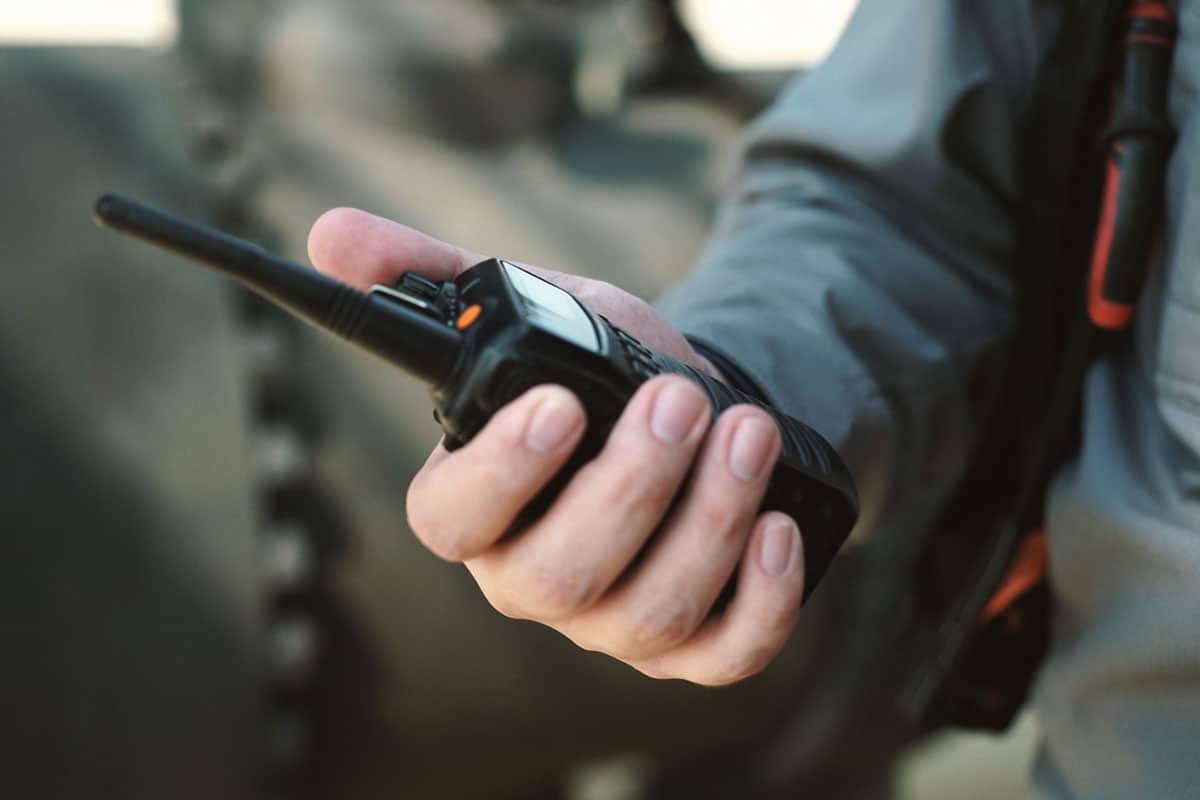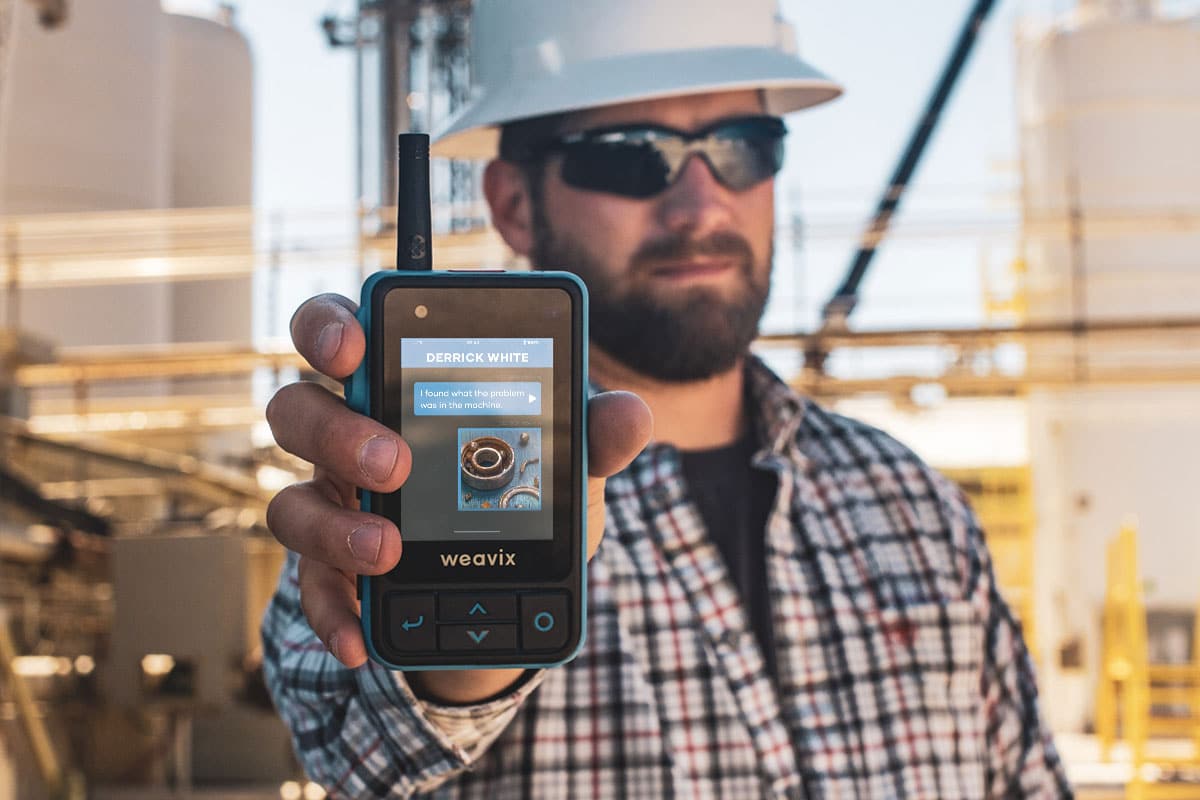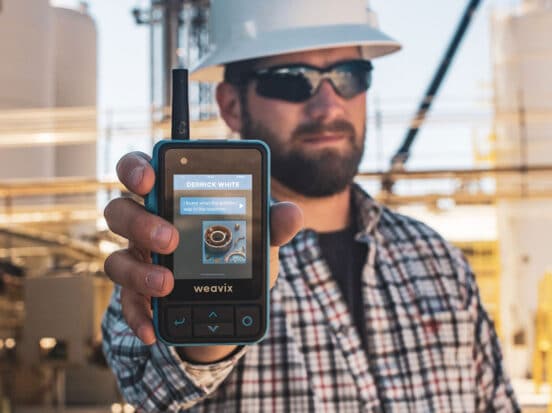Frontline teams depend on clear, instant communication, but most push-to-talk radios create familiar frustrations — complex devices, spotty coverage, and poor integration with digital workflows. As production demands climb and safety standards tighten, plant managers need more than a legacy walkie-talkie to keep operations in sync.
This guide breaks down push-to-talk technology and pinpoints the smartest option for your frontline teams.
Key highlights:
- Push-to-talk is a communication method that lets teams connect instantly at the press of a button (either physical or a virtual button), ensuring real-time voice communication without dialing or waiting.
- Push-to-talk radios enable instant communication, but conventional solutions fall short in range, usability, and integration for modern industrial needs.
- The Walt® Smart Radio System by weavix® redefines push-to-talk communication with AI, multimedia capabilities, and analytics for real accountability and productivity gains.
>>See how the Walt smart radio system works.
What Is Push-to-Talk?
Push-to-talk (PTT) is a communication method that allows users to transmit voice instantly at the press of a button. Traditional PTT systems operate in half-duplex mode, switching the device from listening to speaking mode so that only one person can speak at a time while others listen, ensuring messages are delivered clearly without overlap.
However, modern smart radio systems and digital PTT platforms are beginning to evolve beyond this limitation, with some advanced systems now supporting full-duplex communication that allows simultaneous two-way conversation while still maintaining the convenience and control of push-to-talk functionality for group communications and broadcast scenarios.
Two-way radios, first introduced in the 1930s for police and public safety, were among the earliest devices to use push-to-talk. The technology gained widespread adoption during World War II as a critical tool for military communication. Early devices — like walkie-talkies — relied on radio frequencies to provide reliable, immediate communication in the field.
For a complete history of walkie-talkies, read this feature story on weavix and the history of PTT radios.
What Are the Types of Push-to-Talk Solutions?
Over the decades, push-to-talk solutions have evolved to meet diverse communication needs across various industries. The main types include:

Traditional Two-Way Radios
Two-way radio systems operate on dedicated frequencies, offering reliable voice communication in areas with little or no cellular coverage (e.g., remote construction sites or large facilities). However, traditional push-to-talk walkie talkies are limited to voice-only communication and do not provide analytics, integration, or data capture — leaving blind spots in safety and productivity.
Push-to-Talk Over Cellular (PoC) Radios
Push-to-talk over cellular (PoC) radios use Wi-Fi, LTE, or private LTE networks to deliver broader coverage and advanced features. These modern PTT radios often include GPS tracking, emergency alerts, and device management, making them more scalable across multi-site operations.
Newer smart radios are also beginning to incorporate mesh networking, which allows devices to connect directly to each other without relying solely on cellular or Wi-Fi infrastructure. In environments with poor connectivity or during emergencies, mesh-enabled radios create their own local network, ensuring teams can stay connected even when traditional networks are unavailable.
Push-to-Talk Apps on Smartphones
Smartphone-based push-to-talk apps use cellular data or Wi-Fi networks to mimic the instant communication of two-way radios. Users simply press a virtual PTT button on their screen (or sometimes a connected headset button) to transmit their voice to others in the group.
While smartphones with PTT apps offer convenience, they introduce major risks in industrial environments, such as:
- Distractions from personal apps
- Poor glove usability
- Limited durability
- Security concerns
Smart Radios (Next-Gen PTT)
Systems like the Walt® Smart Radio System by weavix represent the latest evolution of PTT radios — combining rugged hardware with AI-powered software. Features like Push-to-Talk, Picture, Video (PT3), AI transcription, language translation, and data analytics transform our radios from simple communication devices into full operational intelligence platforms.
Meet Walt Smart Radio, the perfect device for the modern frontline workforce.
Who Uses PTT Radios?
Industries around the world rely on PTT radios for instant, reliable communication. According to Precedence Research, the global push-to-talk market reached $33.69 billion in 2024 and is projected to grow to nearly $38.55 billion by 2034.
Industries using PTT radios include:
| Industry | How They Use Push-to-Talk Radios |
|---|---|
| Construction | Foremen, operators, and subcontractors coordinate deliveries, equipment use, and crews; safety alerts reach the entire workforce quickly. |
| Manufacturing | Production, maintenance, and quality teams synchronize workflows, resolve equipment issues, and minimize downtime. PTT is used for manufacturing in food and beverage, automotive, and chemical environments. |
| Transportation and Logistics | Fleet managers and drivers rely on PTT radios for real-time dispatch, route changes, and emergency updates, ensuring reliable deliveries and driver safety. PTT radios are also used in warehousing. |
| Healthcare and Emergency Response | Hospital staff, EMTs, and first responders use radios for secure, instant communication during emergencies when every second matters. |
Despite their widespread use, traditional push-to-talk devices have notable drawbacks, such as:
- Support to voice communication only, therefore lacking the capability to transmit images or videos essential for situational awareness.
- Limited coverage, leading to dead zones, and they frequently require a costly private LTE network or other infrastructure to function.
That’s why modern communication solutions like smart radios, such as Walt by weavix, have emerged — to address these limitations. Beyond voice, these systems support multimedia, use cellular and Wi-Fi for enhanced coverage, and include integrated features like AI language translation, alerting systems, and a comprehensive platform to boost collaboration and safety.
Comparing Traditional Push-to-Talk Devices with Smart Radios
Traditional push-to-talk devices have long been the standard for instant voice communication, but they are increasingly being replaced by modern smart radios due to their enhanced capabilities. This comparison highlights the limitations of legacy PTT devices and the advantages offered by next-generation solutions.
Range and Connectivity
Traditional analog and digital radios operate on fixed frequencies. Their coverage is often limited by distance, buildings, or environmental obstacles. Extending range usually requires costly repeaters, towers, or additional licensing — adding complexity and potential points of failure.
In contrast, a modern smart radio uses existing cellular networks and Wi-Fi to provide virtually unlimited coverage. This technology enables seamless communication across vast distances without requiring additional infrastructure, allowing a company with multiple facilities to maintain consistent communication.
Features and Integration
Conventional PTT devices transmit voice only, but smart radios offer a suite of advanced features designed to reduce the “digital debt” that burdens today’s workforce. In fact, 62% of employees say they spend too much time searching for information, and 68% say they don’t get enough focus time, according to the Microsoft Work Trend Index. Smart radios directly address these challenges with features like:
- GPS tracking and geo-fencing: Smart radios like Walt provide real-time location data, allowing managers to monitor workforce movements and establish geo-fenced areas for safety and operational control.
- Multimedia messaging: Unlike voice-only walkie-talkies, smart radios support text, image, and video messaging, enabling workers to share detailed information instantly for quick decision-making.
- AI-powered language translation and AI transcriptions: In diverse work environments, smart radios with AI-driven translation allow team members to communicate in their native languages, with messages translated in real-time to enhance collaboration.
- Administrative dashboards: Smart radios often come with centralized management platforms that enable administrators to monitor device usage, manage channels, and implement security protocols.
Cost and Deployment
While traditional two-way radios may appear cost-effective initially, they often entail higher long-term expenses due to infrastructure, maintenance, and limited scalability. Setting up a traditional system requires significant investment in repeaters, antennas, and licensing fees.
Smart radios, operating on existing cellular and Wi-Fi networks, eliminate the need for dedicated infrastructure. They offer scalable solutions that operations teams can easily adjust to meet changing business needs.
How Do You Choose the Best Push-to-Talk Radios?
Your choice for the best push-to-talk radios should match the demands of your work environment and the way your teams operate. To make the right decision, evaluate these five key factors:
- Durability and ruggedness: Industrial environments are tough on equipment. Choose radios with high Ingress Protection (IP) ratings, such as IP67 or IP68, to ensure resistance to dust, water, and immersion.
- Compatibility with personal protective equipment (PPE): Workers often wear gloves and other protective gear. Radios should feature large, tactile buttons and simple interfaces that can be used without removing PPE.
- Battery life: Long shifts demand radios with strong battery capacity. Look for models with 20+ hours of runtime on a single charge to avoid mid-shift recharging.
- Integration capabilities: Radios should connect with the rest of your communication and safety systems. Advanced smart radios integrate with dashboards, analytics, and incident management tools to provide both communication and operational insight.
- Ease of onboarding: Communication tools only work if teams adopt them quickly. Look for radios with intuitive interfaces and minimal training requirements so workers can start using them on day one.

Walt® Smart Radio System: The New Standard of Push-to-Talk Radios
Upgrade your frontline communications and unlock new levels of efficiency, safety, and teamwork with the Walt Smart Radio System. Unlike traditional push-to-talk radios, Walt delivers instant, secure voice and multimedia collaboration while supporting a diverse, distributed workforce — eliminating language barriers and streamlining workflows. Plant managers can coordinate between departments, resolve production issues fast, and maintain a safer work environment.
Choose Walt to access:
- Seamless voice, photo, and video messaging for faster problem-solving and clearer coordination across teams
- Real-time language translation and transcription, making collaboration effortless for multilingual workforces
- Geo-fencing, alerting, and GPS location tracking to enhance site safety and rapid incident response
- Waterproof rugged radios engineered for industrial settings and compatible with PPE, ensuring 24/7 reliability
- Centralized cloud management, analytics, and integration with enterprise systems for total operational control
See firsthand how Walt transforms frontline communication into a strategic competitive advantage. Schedule a demo today.
Frequently Asked Questions
How do push-to-talk radios work?
Push-to-talk works by using a dedicated physical or virtual button on a device to instantly switch from listening mode to speaking mode. When the button is pressed, the device transmits the user’s voice over a shared channel, and everyone tuned into that channel hears the message in real time. Once the button is released, the device reverts to listening mode so others can respond.
This method is called half-duplex communication, meaning only one person can speak at a time while the rest listen. Unlike a phone call, there’s no dialing, ringing, or waiting for a connection — the system delivers immediate, clear voice transmission.
How does push-to-talk radio improve team productivity?
Push-to-talk radios enhance team productivity by facilitating immediate communication, which reduces the downtime associated with traditional calling methods. Hands-free operation allows workers to communicate while performing tasks, minimizing disruptions and maintaining workflow efficiency.
The inclusion of AI transcription is also essential for a modern PTT radio. Walt Smart Radio by weavix is one of the few systems that includes AI transcription and AI translation.
Additionally, the inclusion of multimedia messaging enables the sharing of images and videos, streamlining information exchange. Advanced systems like Walt offer transcription and analytics, providing insights into communication patterns and identifying areas for process improvement. Features like message playback ensure no critical detail is missed, eliminating the need for repeat conversations.
What’s the difference between a walkie-talkie and modern push-to-talk walkie talkie?
Walkie-talkies are traditional two-way radios that transmit voice over fixed frequencies. They’re reliable for short-range, voice-only communication but require extra infrastructure (repeaters, towers) for wider coverage. Modern PTT devices, often called smart radios, run on Wi-Fi, LTE, or private LTE networks. They provide nationwide or even global coverage, support multimedia, integrate with digital workflows, and include AI-driven safety and productivity features.
Are push-to-talk radios secure for confidential business use?
Traditional radios offer limited security compared to pushtotalk since they operate on open frequencies that can be intercepted. Modern PTT services solve this with encryption, secure channels, and centralized management controls. This technology ensures sensitive communications — from safety alerts to operational data — remain protected and compliant with organizational security standards.


